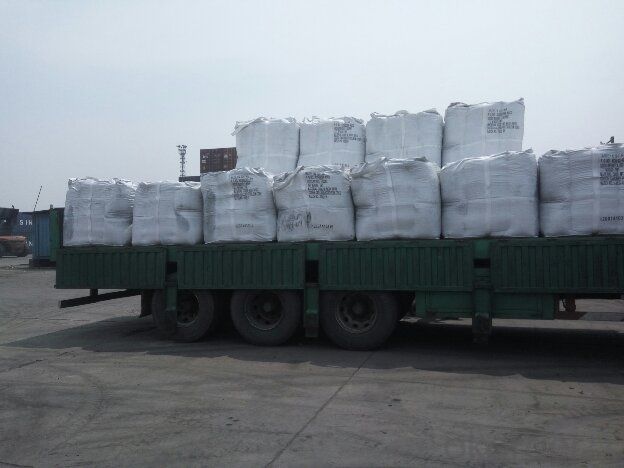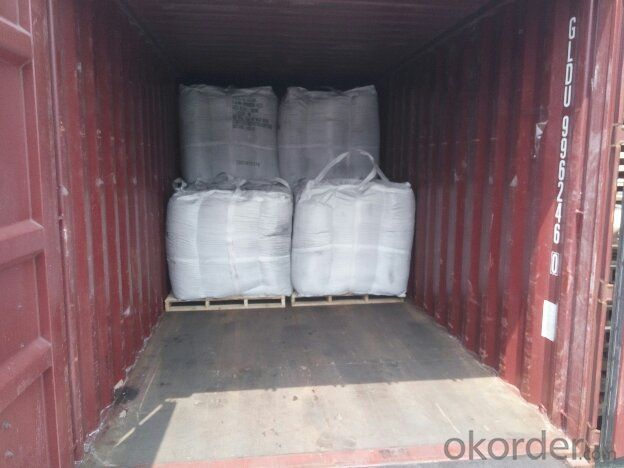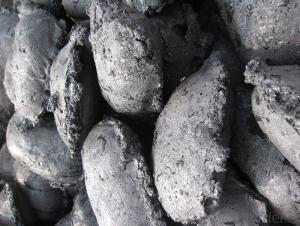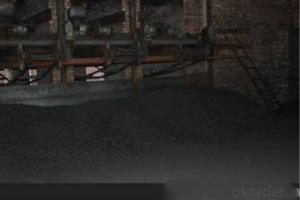Calcined Petroleum Coke as Injection Coke with Sulphur 0.7%max
- Loading Port:
- Qingdao
- Payment Terms:
- TT OR LC
- Min Order Qty:
- 20.1
- Supply Capability:
- 1011 m.t./month
OKorder Service Pledge
OKorder Financial Service
You Might Also Like
Intrduction
Carbon additive to ningxia production of anthracite as raw material, after washing, crushing, high temperature calcination, filter, etc. Craft refined and become.This is after the anthracite calcination generated high carbon content and low volatile component of the new product, is an ideal raw material to make steel.
Calcined Petroleum Coke comes from delayed coke which extracted from oil refinery. Although Calcined Petroleum Coke contains a little bit higher level of sulfur and nitrogen than pitch coke, the price advantage still makes it widely used during steel-making and founding as a kind of carbon additive/carburant.
Features
In the smelting process for reducing agent. Performance: replace the traditional oil carbon additive, decrease the cost of steelmaking. Features: low ash. low sulfur,low phosphorus, high calorific value. High ratio resistance,high mechanical strength,high chemistry activity. It is mainly used for metallurgy reductant inoculants, casting, refractory materials, machinery, electronics and other fields.Good quality
1) high absorption rate, it can be absorbed up to 90%.
2) absorbed more quickly than other carbon additive; no residue remains in furnace.
3) low Sulfur, the lowest can reach below 0.20%; low nitrogen, normally below 200ppm (0.02%)
Specifications
CPC | |||
F.C.% | 98.5MIN | 98.5MIN | 98MIN |
ASH % | 0.8MAX | 0.8MAX | 1MAX |
V.M.% | 0.7 MAX | 0.7 MAX | 1 MAX |
SULFUR % | 0. 5MAX | 0. 7MAX | 1MAX |
MOISTURE % | 0.5MAX | 0.5MAX | 1MAX |
Pictures




FAQ:
(1)CPC could be as fuel
Petroleum coke is a material relatively low in cost and high in heat value and carbon content with good chemical stability, making it an efficient and costeffective fuel for producing metal, brick and related products.
(2)CPC could be as Graphite Electrodes
Graphite can be produced from lowsulfur needle petroleum coke, which must be heated above 5,432 degrees Fahrenheit.
(3)CPC could be as Anodes
Calcined petroleum coke, often low in sulfur and metallic impurities, is used to make anodes for
the smelting industry.Calcined petroleum coke is mixed with coal tar pitch in the production of
anodes.
- Q: What are the advantages of carbon-based nanoelectronics?
- Carbon-based nanoelectronics have several advantages. Firstly, carbon is an abundant and versatile element, making it cost-effective and readily available for large-scale production. Secondly, carbon-based materials, such as graphene and carbon nanotubes, possess exceptional electrical, thermal, and mechanical properties, enabling high-performance and efficient devices. Additionally, carbon-based nanoelectronics offer excellent flexibility and transparency, allowing for the development of flexible and wearable electronic devices. Lastly, carbon-based materials exhibit excellent stability and biocompatibility, making them suitable for various applications, including biomedical devices and sensors. Overall, these advantages make carbon-based nanoelectronics a promising platform for future advancements in electronics.
- Q: How can I see if a battery can be used to recharge it?Can not all carbon batteries charge?
- Can not but about 4 times more than that of carbon battery alkaline batteries we usually use 5 batteries and 7 batteries into several carbon batteries alkaline batteries, carbon battery prices cheaper than half cheaper but durable alkaline battery alkaline batteries and strong power in general can reach carbon batteries are not can charge are one-time non rechargeable battery voltage both 1.5V are generally belongs to the zinc manganese batteryNo. 5 and No. 7 rechargeable battery is generally divided into two kinds of nickel cadmium battery NiMH battery is the two voltage of Ni MH battery capacity rechargeable nickel cadmium batteries so the current market is generally greater than the mountain NiCd battery has been relatively rare these two batteries each day is 1.2V can be chargedNote that our commonly used mobile phone lithium battery voltage is generally about 3.6 to 3.7V, or 3.6 multiples, so do not make the No. 5 or 7 batteries
- Q: What are the properties of activated carbon?
- Activated carbon, also known as activated charcoal, possesses several unique properties that make it highly versatile and useful in various applications. 1. Adsorption: One of the most significant properties of activated carbon is its high adsorptive capacity. It has a vast internal surface area due to its porous structure, which allows it to effectively adsorb molecules, ions, and impurities from gases, liquids, and solids. This adsorption capability makes it ideal for purification purposes, such as water and air filtration, as well as in the removal of toxins and pollutants from industrial processes. 2. Porosity: Activated carbon has a highly porous structure with a network of interconnected pores. This porosity provides a large surface area, enabling it to trap a significant amount of contaminants. The pores can be classified into three types: micropores (less than 2 nm), mesopores (2-50 nm), and macropores (greater than 50 nm), each contributing to its adsorption capacity. 3. Chemical Stability: Activated carbon exhibits excellent chemical stability, making it resistant to degradation and breakdown when exposed to various chemicals or environments. This property allows it to maintain its adsorption capacity over a long period and under harsh conditions, ensuring its efficiency and longevity in different applications. 4. Selectivity: Activated carbon can be tailored to exhibit selectivity towards specific substances by modifying its surface properties. Through various activation processes, such as physical or chemical treatments, the surface chemistry of activated carbon can be altered to enhance its affinity for certain molecules or contaminants, while reducing its affinity for others. This selectivity makes it an effective material for specific applications, such as removing specific pollutants or capturing desired compounds. 5. Regenerability: Another advantageous property of activated carbon is its regenerability. After reaching its adsorption capacity, it can be regenerated by heating or washing with appropriate solvents, allowing it to be reused multiple times before replacement. This regenerability not only reduces the operational costs but also contributes to its sustainability and eco-friendliness. 6. Low Density: Activated carbon has a relatively low density, making it lightweight and easy to handle. This property enables its use in various systems and devices without adding excessive weight or bulk. 7. Thermal Stability: Activated carbon possesses high thermal stability, allowing it to withstand high temperatures without significant degradation. This property makes it suitable for applications involving high-temperature processes, such as gas purification or catalytic reactions. Overall, the properties of activated carbon, including its adsorption capacity, porosity, chemical stability, selectivity, regenerability, low density, and thermal stability, make it a versatile material widely used in water and air purification, gas separation, chemical processing, pharmaceuticals, and many other industries.
- Q: How does carbon impact the prevalence of landslides?
- The prevalence of landslides is significantly influenced by carbon dioxide (CO2) in the form of carbon. One of the main ways carbon affects landslides is by contributing to climate change. The increase in CO2 levels in the atmosphere causes global warming, which changes weather patterns, precipitation levels, and the overall stability of slopes and landforms. Carbon emissions leading to climate change result in more frequent and intense rainfall events in many areas. This heightened rainfall saturates the soil and raises groundwater levels, making slopes more prone to landslides. Additionally, intense rainfall erodes the soil, further compromising slope stability and increasing the chances of landslides. Another impact of carbon on landslide prevalence is its influence on vegetation. Carbon dioxide is crucial for photosynthesis, the process plants use to convert sunlight into energy. However, elevated CO2 levels can negatively affect plant growth and productivity. Plants play a vital role in stabilizing slopes and preventing erosion through their extensive root systems. When carbon levels are high, plants may experience stunted growth, weakening their ability to anchor the soil and protect against landslides. Furthermore, carbon emissions contribute to the melting of glaciers and permafrost, which can trigger landslides in mountainous regions. Glaciers serve as natural stabilizers, holding large amounts of rock and soil in place. When glaciers melt due to global warming, the sudden release of this material can trigger landslides with devastating consequences. In conclusion, carbon primarily impacts the prevalence of landslides through its contribution to climate change and subsequent effects on weather patterns, vegetation growth, and slope stability. It is crucial to address carbon emissions and mitigate climate change to reduce the occurrence and severity of landslides.
- Q: What's the difference between blue and red Panasonic batteries (carbon)?
- Blue is leak, proof, general, Purpose, general use battery (leak proof)Red is the long life long life battery (suitable for watches and clocks and other small power appliances)And heavy duty green seems to be good for high power appliances, such as toy cars
- Q: What is carbon nanocomposite?
- Carbon nanocomposite refers to a material that is made up of carbon nanoparticles embedded in a matrix material. This combination results in a material that exhibits enhanced mechanical, thermal, and electrical properties, making it suitable for a wide range of applications such as aerospace, electronics, and energy storage.
- Q: Is carbon monoxide good for people?
- No good, generally will cause poisoning, gas poisoning is actually carbon monoxide poisoning
- Q: What are the consequences of increased carbon emissions on global food security?
- Increased carbon emissions have significant consequences on global food security. One of the most immediate impacts is the alteration of weather patterns and increased frequency of extreme weather events such as droughts, floods, and heatwaves. These events can lead to crop failures, reduced agricultural productivity, and loss of livestock, ultimately resulting in food shortages and price volatility. Carbon emissions also contribute to climate change, leading to long-term shifts in temperature and precipitation patterns. Higher temperatures can accelerate the growth and reproduction rates of pests and diseases, which can devastate crops and livestock. Additionally, changes in rainfall patterns can disrupt the timing and quantity of water available for irrigation, further reducing agricultural productivity. Furthermore, carbon emissions contribute to the acidification of oceans, which negatively affects marine ecosystems and the livelihoods of communities dependent on fishing and aquaculture. This can lead to a decline in fish stocks, threatening the availability of a vital source of protein and nutrition for millions of people. Another consequence of increased carbon emissions is the loss of biodiversity. Climate change can disrupt ecosystems, leading to the extinction or migration of plant and animal species. This loss of biodiversity reduces the resilience and adaptability of agricultural systems, making them more vulnerable to pests, diseases, and environmental stresses. Ultimately, the consequences of increased carbon emissions on global food security are far-reaching and complex. They include decreased agricultural productivity, increased food prices, food shortages, and reduced access to nutritious food. Addressing carbon emissions and mitigating climate change is crucial to ensure a sustainable and secure global food system for future generations.
- Q: How does carbon impact the melting of polar ice caps?
- Carbon impacts the melting of polar ice caps primarily through climate change. Carbon dioxide (CO2) is a greenhouse gas that traps heat in the atmosphere, causing the Earth's temperature to rise. This increase in temperature leads to the melting of polar ice caps. When carbon is released into the atmosphere through human activities such as burning fossil fuels, deforestation, and industrial processes, it accumulates and contributes to the greenhouse effect. As the concentration of CO2 increases, more heat is trapped, resulting in the warming of the planet. Polar ice caps, especially in the Arctic and Antarctica, are particularly vulnerable to this warming. The melting of the ice caps is accelerated by rising temperatures, causing them to shrink and eventually collapse. This process is known as ice cap retreat. The impact of carbon on polar ice caps is twofold. Firstly, the melting of ice caps contributes to sea-level rise, which poses a significant threat to coastal communities and low-lying areas worldwide. As the ice caps melt, the water from them flows into the oceans, causing them to expand. This can lead to coastal erosion, increased flooding, and the loss of valuable habitats and ecosystems. Secondly, the melting of polar ice caps also disrupts the delicate balance of the Earth's climate system. The reflective surface of ice helps to regulate the planet's temperature by reflecting sunlight back into space. As the ice melts, it is replaced by darker surfaces such as water or land, which absorb more heat. This further exacerbates global warming, creating a feedback loop that accelerates the melting process. Overall, the impact of carbon on the melting of polar ice caps is profound. The continued release of carbon into the atmosphere is contributing to the loss of these critical ecosystems, causing sea-level rise, and disrupting the Earth's climate system. To mitigate these effects, it is crucial to reduce carbon emissions and transition to cleaner and more sustainable sources of energy.
- Q: The same manufacturer of different types of badminton rackets on the logo, but the two materials in the end what is the difference?
- This Master ask is this, that is the general elevator racket high modulus graphite ball afraid pat dry than the conventional full carbon racket do more flexibility, recovery at the moment of the ball faster, feel better. That is like the racket elevator high rigid carbon fiber that is needless to say better, because the racket miserably into the high rigidity of carbon fiber, the racket of high hardness, carbon racket is more uniform in the sand volume, better stability of the drive moment of the racket, bending time to recover faster, smash more accurate placement.
Send your message to us
Calcined Petroleum Coke as Injection Coke with Sulphur 0.7%max
- Loading Port:
- Qingdao
- Payment Terms:
- TT OR LC
- Min Order Qty:
- 20.1
- Supply Capability:
- 1011 m.t./month
OKorder Service Pledge
OKorder Financial Service
Similar products
Hot products
Hot Searches
Related keywords


























